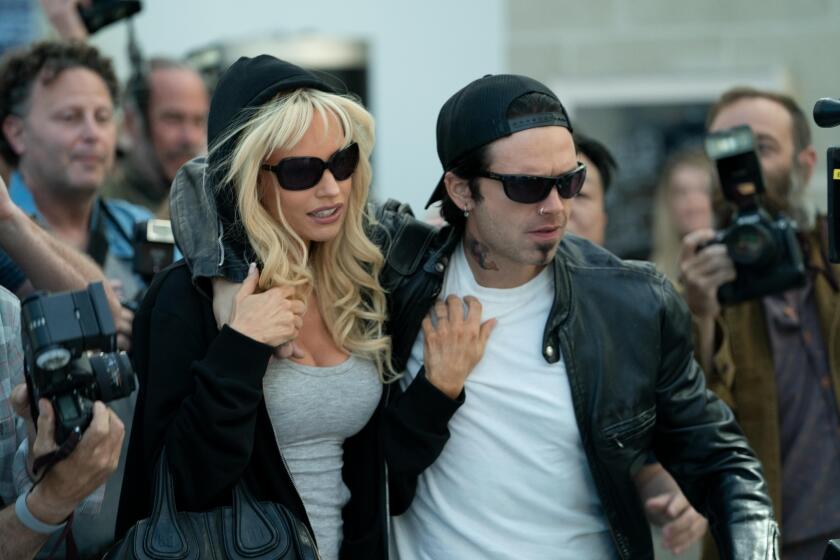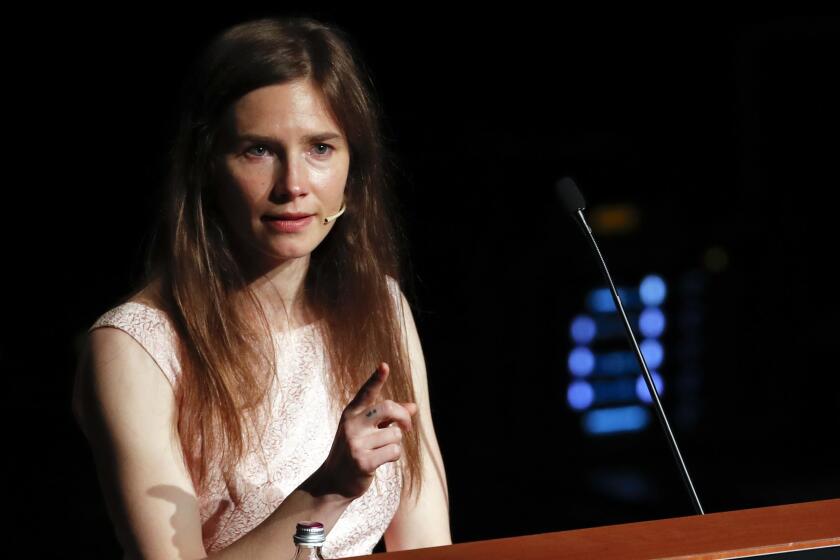How ‘Pam & Tommy’s’ ‘standout episode’ brought Anderson’s side of the story to life
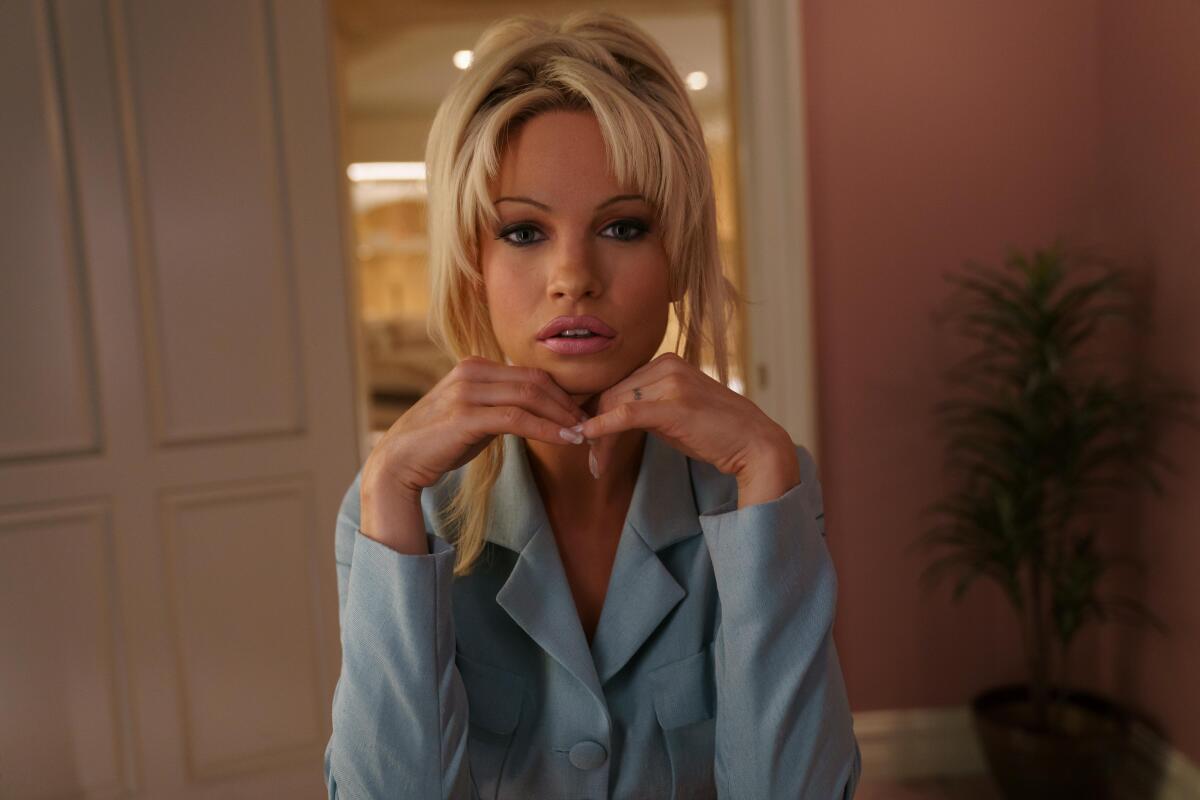
- Share via
“Pam & Tommy” takes a rollicking look back at one of the most salacious stories of the 1990s — the intimate home movie made by Mötley Crüe drummer Tommy Lee and “Baywatch” star Pamela Anderson during the early days of their volatile marriage, subsequently stolen from their home by a disgruntled electrician, then sold without their consent on the internet.
Created by Robert Siegel, the series provides a sprawling, diffuse look at the culture of the mid-1990s, touching on everything from the misogyny of late-night TV and changing taste in popular music to the mechanics of the early web and the role of the VCR in the pre-internet porn industry.
It has given viewers much to contemplate, including a talking penis.
But until Wednesday, it had largely left Anderson’s backstory unexplored. Now, with “Pamela in Wonderland,” “Pam & Tommy” delivers a powerful episode that puts her perspective front and center.
To accompany the premiere of Hulu’s ‘Pam & Tommy,’ we’ve compiled a timeline of key developments in the saga, with Times coverage.
Written by Sarah Gubbins (a playwright and screenwriter whose credits include “Better Things” and “Shirley”) and directed by Hannah Fidell (“The Act,” “A Teacher”), the episode opens as Anderson (Lily James) prepares to be deposed as part of a lawsuit she and Lee (Sebastian Stan) have filed against Penthouse magazine for publishing stills from the video.
As Anderson is grilled with degrading questions like “Do you recall how old you were the first time you publicly exposed your genitals?” and forced to identify herself in the stolen sex tape as it’s played for a room full of strangers, the episode flashes back to trace her journey from Ladysmith, Canada, to the Playboy Mansion and beyond.
It all begins in August 1989, when a young Anderson is discovered in the crowd at a football game, leading to a stint as a beer spokesmodel and, ultimately, a call from Playboy. After ditching her violent and controlling boyfriend, she travels to Los Angeles for her first pictorial. Initially nervous, she quickly comes to life in front of the camera. A star is born.
Both Gubbins and Fidell say they were eager to work on this episode because of its focus on Anderson.
“There’s so much depth, and it’s so layered, and I’m personally just drawn to stories of women in crisis,” Fidell said. “It just seemed like, really, the standout episode.”
Here’s a look at how they brought her side of the story to life.

I am interested in the research you did for this episode and how deep down the rabbit hole you went, starting with the deposition. Did you dig up the actual transcripts?
Gubbins: I went very deep. I come from a family of lawyers. The law is something that I’m fascinated by, and I love reading depositions. This is something I really hope you don’t print, because I’ll never get invited to any cool events ever again. [Laughs] We petitioned aggressively to get as many of the legal documents as were available. I did a lot of Lexis Nexis searches and got descriptions of various aspects of what happened in the court. But ultimately the deposition itself is a reconstruction for television of what might have been prompts in that deposition, building back from the outcome of the case.
So you imagined what the conversation might have been like, given the general discourse around the case and the outcome of the lawsuit?
Gubbins: Yes, and I was able to nail down such things as lines of questioning without being given direct questions, if that makes sense. I was able to get a sense of the tenor of the deposition and the treatment of her. Depositions are not meant to be easy things regardless of what you’re being deposed for, but this seemed to be an an excessively egregious treatment of Pamela, separate from Tommy. And that’s all based in what we were able to get in the legal research.
Reframing of the couple’s sex tape saga has mixed results, but the series’ treatment of culture at the dawn of the internet is stupidly entertaining.
Was she made to watch the tape with other people, as we see in the episode?
Gubbins: I don’t know if that’s a real thing, but I do know that it is a common deponent practice to have to identify oneself in evidence they would be presented with. It’s almost like standard practice.
Fidell: I also come from a family of lawyers. And I ran this by them to make sure it sort of stood up to their scrutiny and it passed muster.
Something else that stood out to me is the sequence at the Playboy Mansion where she poses nude for the first time. She is uncertain at first but really comes alive and seems happy by the end of the shoot. It doesn’t feel exploitative. What were you trying to convey in that scene?
Fidell: I think we spent the most time discussing that sequence. Pam loved posing for Playboy; she was good at it, it was empowering for her, she took ownership over it and ownership over her body. And having that as an emotional journey over the course of those few minutes was very important to the arc of the episode. We made sure that she started out nervous and then gained confidence by the end of it — really owned the room — and became the Pam that everyone knows now.
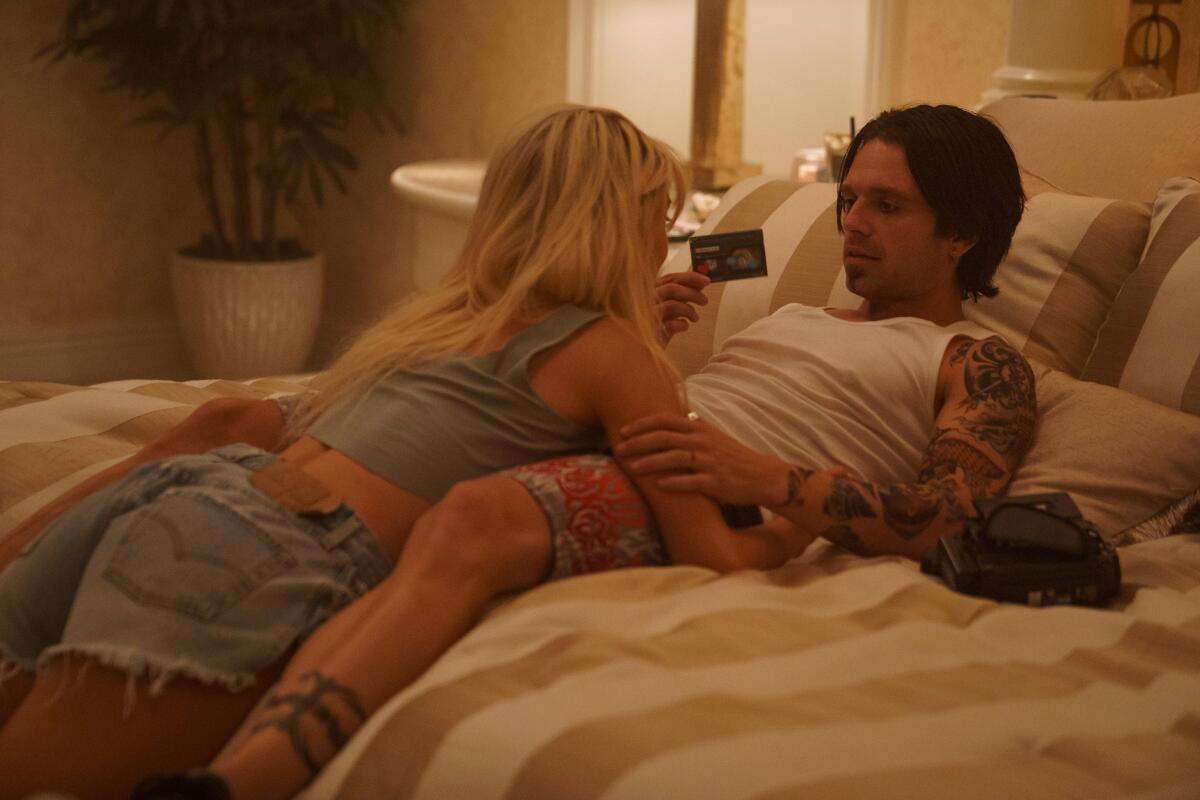
Lily James as Pamela Anderson and Sebastian Stan as Tommy Lee in “Pam & Tommy.”
When you were researching the coverage of the lawsuit at the time, what struck you about it?
Gubbins: We read a bunch of news coverage from when the tape came out, and I was really struck by how, across the board, it was handled with such misogyny. I don’t remember when the term “slut-shaming” came into the popular parlance, I don’t think that was something that was dripping off of people’s tongues [in the ‘90s], but from the lens of our present day, it was jaw-dropping to me how overt the misogyny was, and the way in which Pam versus Tommy were handled in the coverage.
We’ve seen a number of projects reconsidering women from this era: Britney Spears, Monica Lewinsky, Marcia Clark and now Pamela Anderson. The culture really seems to be reckoning with the sexism of the ‘90s. I wonder if you have thoughts about why now and what has shifted in the culture that makes us more conscious of the way we treated these women at the time?
Gubbins: I don’t think that it’s coincidental. I think it’s very necessary to go back to the ‘90s. Because this is a moment, politically speaking, where women have tried to come into various positions of power and agency in many arenas. And the struggle to define what are inherent biases about women in power and where they stem from is generational. We are going back to the ‘90s and saying, “Where did this begin for us?” We’re reexamining something that we didn’t even understand we were growing up with. And I’m saying that as somebody who’s in my mid-40s.
We’re trying to grapple with what is bubbling up, this persistent misogyny. Why are we so uncomfortable giving women a voice? Why are we so uncomfortable giving women a seat at the table? Where did that come from for us? And going back to these events of the ‘90s is going to help us answer those questions.
Eager to shed her ‘likable’ image, the Brit signed on to play a woman whose private life went very public. Then the tabloid spotlight shined on her.
When it came to filming this episode, were you conscious of framing Pamela in ways that were different from how she was typically portrayed — avoiding the male gaze and ogling her body through the camera?
Fidell: Yes, very much — speaking of internalized misogyny. Paula [Huidobro], the director of photography, is a woman. And both of us came to this episode from a place of really wanting the audience to empathize with Pam. And the way to do that, just from a technical perspective, is to not have a traditional male gaze. Because then the female subject becomes objectified. So it’s making sure that the camera is close when we want her to feel claustrophobic. The Playboy Mansion feels exciting, so we shoot it with a wide lens. It really needs to mirror everything that she is feeling in the moment. So we made sure that that was our mantra moving forward.
From the start I thought this episode should look different than the previous ones, because we’re actually spending the entirety of the episode in her perspective. It shouldn’t look like how Rand or Tommy’s scenes would look and feel, especially for those Playboy [scenes]. We utilized the actual first Playboy photos that she took and tried to mimic them as best we could. There’s a lot of reference material to pull from, which was great for all of the heads of departments, but especially for Lily.
You tell her story very economically, in just over 30 minutes of screen time. How did you decide which moments from her life to include in this episode?
Gubbins: I felt it was really important to find moments of agency, where she was being given a choice. That stands in stark contrast to having some personal property burglarized and then blasted across the internet. Dramaturgically that’s what’s driving those flashbacks. Emotionally she’s recounting these moments where her life changes or where her life could have gone a different way, but she’s also remembering what her dreams for her life were. During a grueling deposition, where her agency is just being eradicated, what gets her through that?
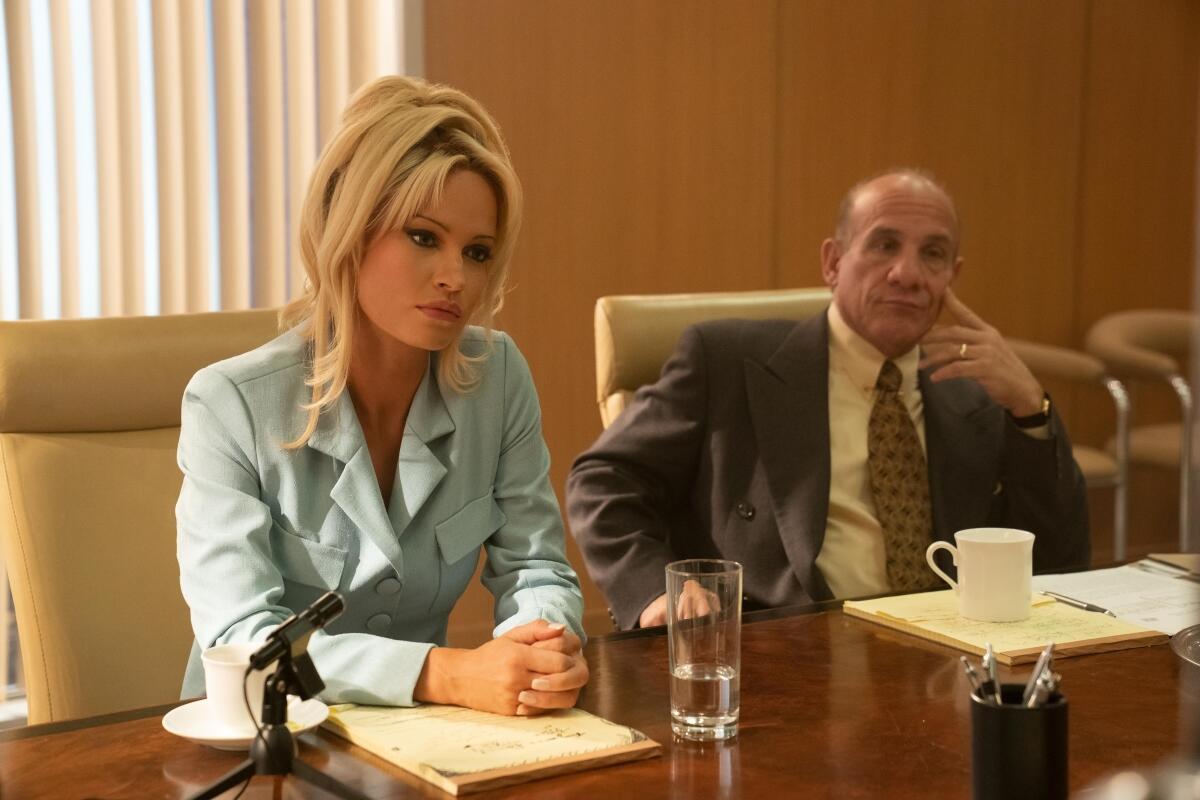
There has been some criticism of this show because Anderson was not involved in making it. Given that she wasn’t involved creatively, I wondered how you ensured that this story wasn’t overly salacious and didn’t exploit someone who had already been exploited?
Fidell: Lily and I talked quite a bit about this, and we both feel such sympathy for Pam, and I hope that comes across in both the performance and in the way this episode was shot. But that was in order to do her justice.
Gubbins: That was a big concern that was very, very present in the writers room — about treating Pamela’s character in a way that expanded our perception of her, not as just somebody who was on this page. By creating a fictional character that has strengths that we all perceived in Pamela, we were hoping to create more sympathy for what she had endured. That was always our intention. And it was something that was incredibly present in the breaking of the story and in the writing of this episode and, I think, with the ways in which Hannah and Lake [Bell] and all the directors approached her character. That was a core mission.

